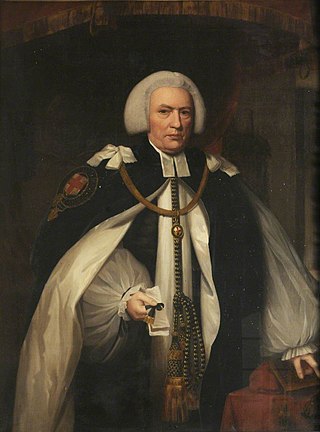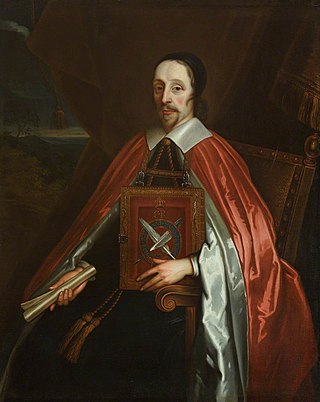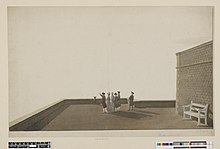
The Most Noble Order of the Garter is an order of chivalry founded by Edward III of England in 1348. The most senior order of knighthood in the British honours system, the only decorations which outrank it in precedence are the Victoria Cross and the George Cross. The Order of the Garter is dedicated to the image and arms of Saint George, England's patron saint.

John Douglas was a Scottish scholar and Anglican bishop.
Christopher Urswick (1448–1522) was a priest and confessor of Margaret Beaufort. He was Rector of Puttenham, Hertfordshire, and later Dean of Windsor. Urswick is thought to have acted as a go-between in the plotting to place her son Henry VII of England on the throne.

Field Marshal Charles Lennox, 3rd Duke of Richmond, 3rd Duke of Lennox, 3rd Duke of Aubigny,, styled Earl of March until 1750, of Goodwood House in Sussex and of Richmond House in London, was a British Army officer and politician. He associated with the Rockingham Whigs and rose to hold the post of Southern Secretary for a brief period. He was noteworthy for his support for the colonists during the American Revolutionary War, his support for a policy of concession in Ireland and his advanced views on the issue of parliamentary reform. He is believed by many to be the source of the second parchment copy of the US Declaration of Independence, known as the 'Sussex Declaration'. He went on to be a reforming Master-General of the Ordnance first in the Rockingham ministry and then in the ministry of William Pitt.

Prince William Henry, Duke of Gloucester and Edinburgh,, was a grandson of George II and a younger brother of George III of the United Kingdom.

The Society of the Friends of St George's and Descendants of the Knights of the Garter is a constituent group of the Foundation of the College of St George, Windsor Castle which is a national charity in England. The society includes more than 5,100 members worldwide to "protect, preserve and enhance" the college, its St George's Chapel, Windsor Castle and the royal chivalric knighthood, the Order of the Garter.

David Vines White OStJ, a member of the Royal Household, has since 2021 served as Garter Principal King of Arms.

Matthew Hutton was a high churchman in the Church of England, serving as Archbishop of York (1747–1757) and Archbishop of Canterbury (1757–1758).
John Travers was an English composer who held the office of Organist to the Chapel Royal from 1737 to 1758. Before filling several parochial posts in London he had been a choir boy at St. George's Chapel, Windsor, and a pupil of Johann Christoph Pepusch.
James Goldwell was a medieval Dean of Salisbury and Bishop of Norwich.

Sir Cennydd George Traherne was a notable Welsh landowner.

John Fisher was a Church of England bishop, serving as Bishop of Exeter, then Bishop of Salisbury.

St George's Chapel at Windsor Castle in England is a castle chapel built in the late-medieval Perpendicular Gothic style. It is a Royal Peculiar, and the Chapel of the Order of the Garter. St George's Chapel was founded in the 14th century by King Edward III and extensively enlarged in the late 15th century. It is located in the Lower Ward of the castle.

John Gumley was an English furniture-maker, army contractor and MP.
John Wickart D.D. was a Canon of Windsor from 1684 to 1722 and Dean of Winchester from 1693 to 1722.
John Mandeville was a Canon of Windsor from 1709 to 1722 and Dean of Peterborough from 1722 to 1725.
Dr Penyston Booth,, also Peniston Booth, was an 18th-century Anglican priest, who hailed from the minor gentry, and served as Dean of Windsor from 1729 to 1765.

Christopher Wren B.D. was an Anglican cleric who was Dean of Windsor from 1635 until his death, and the father of the prominent architect Christopher Wren.
John Corynham was a Canon of Windsor from 1416 to 1444

Sir John Peachey, 2nd Baronet, of West Dean, Sussex, was a British landowner and Tory politician who sat in the House of Commons from 1738 to 1744.














